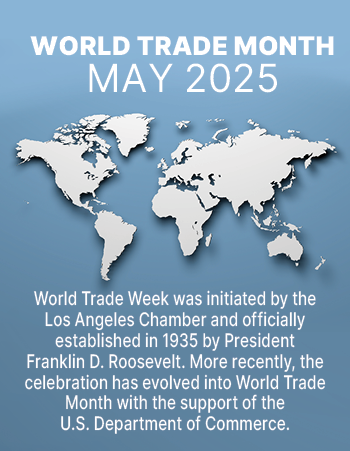
As World Trade Month begins, the California Chamber of Commerce is emphasizing its long-held support for a national free trade agenda and the significance of international trade in maintaining economic growth.
World Trade Month activities provide opportunities to acknowledge the importance of global trade to the economies of California and the United States and celebrate how international trade unlocks new business opportunities, creates jobs, and strengthens the U.S. and global economy.

Formula for Growth
The CalChamber encourages interest in and understanding of international trade as a vital part of our economy. Too often the positive economic impact of international commerce on our state’s economy is taken for granted, without considering that:
- Exports bring in new money;
- Imports bring in more cost-effective materials and resources; and
- Investment provides new economic development in our state.
California is proof positive of that formula. According to the International Monetary Fund’s 2024 World Economic Outlook data released April 22, 2025, California’s nominal gross domestic product (GDP) reached $4.1 trillion, placing California behind only the United States, China, and Germany in global rankings.
In 2024, California exported $183.34 billion to more than 225 foreign economies. California’s top export markets are Mexico, Canada, China, Japan and Taiwan.
That is why, each May, Californians participate in the observance that began as World Trade Week in California in 1926 and was proclaimed a national observance in 1935 by President Franklin D. Roosevelt.
Since World War II, the world has been in an era of globalization and trade liberalization. Income and exports have grown, and extreme poverty has decreased. The United States has developed free trade agreements with Australia, Bahrain, Chile, Colombia, Central America, Israel, Jordan, Mexico and Canada, Morocco, Oman, Panama, Peru, Singapore, and South Korea. These free trade agreements translate into the removal of billions of dollars in tariffs and nontariff barriers for U.S. exports.
Since 1944, countries have relied on a set of trade rules, first under the auspices of the General Agreement on Tariffs and Trade and since 1993, on the more updated World Trade Organization (WTO), as the only global international organization dealing with the rules of trade between nations.
But the WTO is faltering and trading partners do not always adhere to the rules — leaving the 166 WTO governments, which together account for 98% of world trade, struggling with uncertainty.
Trump Administration
The new Trump administration promised the most disruptive change in Washington, D.C. ever seen. From the inaugural speech and into the early part of the new administration, there has been much speculation about the extent tariffs may be used in three ways: to protect domestic industries from the unfair practices of foreign companies and foreign markets, to raise revenue for the federal budget, and as leverage in foreign negotiations rather than the use of sanctions.
President Donald Trump stated in his inaugural speech, “I will immediately begin the overhaul of our trade system to protect American workers and families. Instead of taxing our citizens to enrich other countries, we will tariff and tax foreign countries to enrich our citizens.”
After an initial flurry of activity of temporarily placing tariffs on Colombia, and also Mexico and Canada, on Wednesday, April 2 — which he called “Liberation Day” — President Trump announced new reciprocal tariffs from the first Rose Garden ceremony, with a number of Cabinet officials and members of Congress in attendance.
According to the White House fact sheet, President Trump imposed responsive tariffs to “strengthen the international economic position of the United States and protect American workers.”
As the basis to impose these tariffs, the President invoked his authority under the International Emergency Economic Powers Act of 1977 (IEEPA) to “address the national emergency posed by the large and persistent trade deficit that is driven by the absence of reciprocity in our trade relationships and other harmful policies like currency manipulation and exorbitant value-added taxes (VAT) perpetuated by other countries.”
President Trump imposed a 10% tariff on all countries, effective April 5, 2025. He then imposed an individualized reciprocal higher tariff on the countries with which the United States has the largest trade deficits. All other countries will continue to be subject to the original 10% tariff baseline — effective April 9, 2025.
While President Trump’s trade policy announcements continued to create uncertainty, as well as affecting consumer prices, the stock market and consumer confidence, the President paused the tariffs for 90 days, substantially lowered reciprocal tariffs during this period to 10%, yet raised the tariff charged to China to a total of 145%.
Since then, as many as 100 governments around the world have indicated an interest in negotiating tariffs with the Trump administration, which has focused on top U.S. trading partners; 17 proposals are on the table.
Uncertainty continues, however, especially in light of the April 30 report that U.S. GDP declined for the first quarter of 2025. The concern is that the economic impact of the tariffs soon will be felt in full force.

CalChamber Position
The CalChamber will continue to focus on lowering and eliminating tariff and nontariff barriers to support the expansion of American exports. While strategic use of tariffs or the threat of tariffs may be a meaningful negotiation tool, the CalChamber supports efforts to reduce taxation and regulatory burden as a means to create jobs and economic growth. Further, a focus on trade agreements instead will ultimately lower both tariff and nontariff barriers and help create long-term, sustainable economic growth.
The CalChamber opposes protectionist measures which create uncertainty, disrupt global supply chains, raise consumer prices, limit choices of products for consumers, hinder the competitiveness of California businesses, and invite retaliation.
The CalChamber believes strengthening economic ties and enhancing regulatory cooperation through agreements with our top trading partners that encompass both goods and services, including financial services, is essential to eliminating unnecessary regulatory divergences that may act as a drag on economic growth and job creation.
The CalChamber seeks commercially meaningful outcomes in negotiations with regions around the world and supports bilateral, regional and multilateral trade agreements, which are critical to consumers, workers, businesses, farmers and ranchers, and would allow the United States to compete with other countries that are negotiating agreements with each other.
California’s economy is diverse, and the state’s prosperity is tied to exports and imports of both goods and services by California-based companies, to exports and imports through California’s transportation gateways, and to movement of human and capital resources.
International trade and investment are major parts of our economic engine that broadly benefit businesses, communities, consumers and state government. We need to recognize this not only each May, but every month of the year.
Susanne T. Stirling is senior vice president of international affairs for the California Chamber of Commerce.

